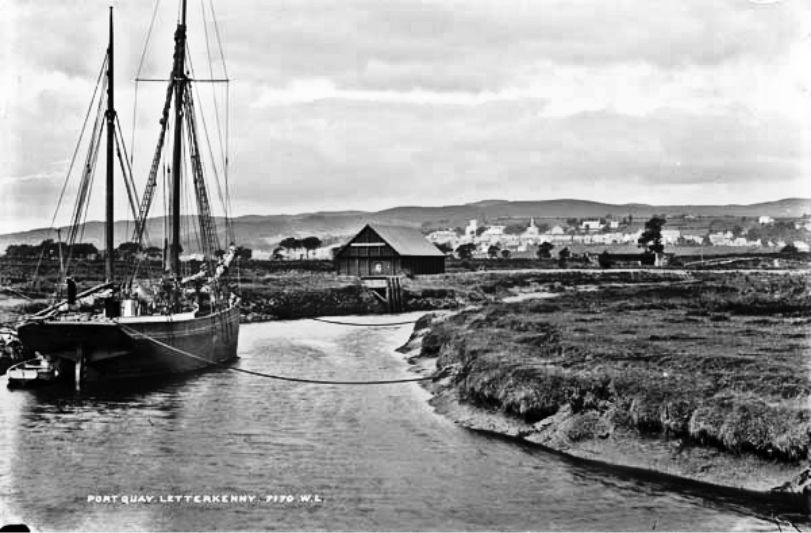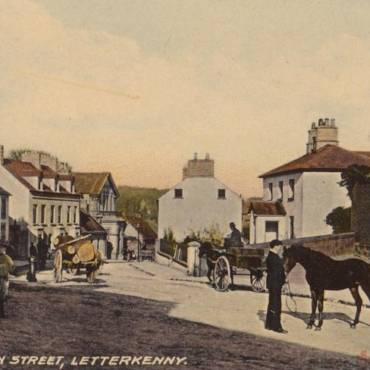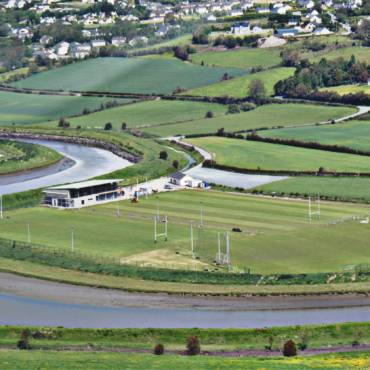Port Ballyraine
One of the major factors of economic growth in Letterkenny in the nineteenth and early twentieth centuries was undoubtedly the role of the Port at Ballyraine. Set up in the late eighteenth century to facilitate the arrival of goods into the nearby small market town, on January 10th1775, I. Monck Mason reported on its poor condition:
“The port of Ballyrain is yet in its infancy, but is worthy of your attention from the circumstances of its situation within a quarter of a mile of Letterkenny, a very considerable town in the midst of a populous country, and in one of the finest harbors in the world; for such I may venture to pronounce Lough Swilly. There never was a port however in a more deplorable condition, than it is at present: without a quay, Custom House, or boat; without a road passable for carriages from thence to the town, & provided with scarcely a single officer, who both knows his business and is able to execute it.
The Grand Jury of the County of Donegal have granted a presentment for making a road from Ballyrain to Letterkenny, which will probably be completed early in the spring.”
People who worked at the Port at this time were John McCausland, Henry Cooper, John Witherall, William McMullan and William Birch while the boatmen were John Hunter and George Swiney but“as there has never been a boat provided for them, these officers have hitherto had nothing to do.”
William Boyd of Ballymacool and later of Gortlee was the Collector for the Port at this time. By 1824, conditions at the Port appeared to have improved:
“Within half a mile is Port Balliraine, whither vessels of one hundred tons bring iron, salt, colonial produce, and whence they export hides, butter etc. This is the market for a very considerable tract of county: the principal commodities sold here are linen, yarn, cattle, and provisions.”
While visiting Letterkenny in 1854, Henry D. Inglis remarked that:
“…there is a considerable export trade in corn. About fifty cargoes, averaging seventy tons are dispatched in a season, making the whole export between three and four thousand tons.”
This thriving corn market was located on the Main Street from 1852, as evidenced by the sign still in existence today.
In 1900, one of Letterkenny’s most successful businessmen at the time, William George McKinney, bought the Port with the surrounding coal yards, sheds and warehouses from the Ramsay family. Another successful businessman, Charles Kelly from Ramelton, was a tenant of the Ramsays in one of the warehouses and was negotiating to buy the property himself when McKinney outbid him and became his new landlord. The Kelly family would eventually get ownership of the Port forty years later though.
W.G. McKinney (not to be confused with the McKinneys on the Port Road who later owned Oatfields) ran a very successful business on the Main Street selling ladies and gents shoes while also working a funeral business and a farm at the bottom of Rosemount and serving on the Urban Council. His purchase of the Port effectively gave him control of the River Swilly in this area and for many years he held the large contract for supplying St. Conal’s Hospital with 12,000 tons of steam coal while he sold and delivered up to 5,000 tons of coal per year throughout the local area. McKinney died in 1931 in what was described as a largely attended and solemn funeral. Ten years later A.D. Kelly, the son of Charles Kelly, successfully purchased the port from Cecil McKinney and from then until the 1960s the firm of Charles Kelly Ltd. imported coal, salt, timber, and fertiliser through the port. Sawn timber was imported from Finland, Sweden and Norway for their Mill at Ballymacool while coal came from North West England, Scotland and South Wales and later from Poland and Holland.
In 1937, Paddy Tinney, then working with another successful local businessman Sam Roulston at the bottom of the Main Street, began importing coal through the Port and opened a business with his sons Charlie and Eddie on the Port Road. The Electrification of Rural Ireland programme began in 1945 and again the Port was instrumental as large vessels brought thousands of wooden poles from Europe after being treated with creosote in Dublin, Cork and Limerick. These large poles were then taken to all parts of the county and erected, connecting the various outlying areas with electricity.
By the 1960s, the days of large and small ships arriving at the Port at Ballyraine appeared numbered as a new pier had been built downriver at the Thorn. This could accommodate much larger coasters meaning that Ballyraine was gradually used less and less. In 1980, due to repairs being done at the Thorn, a Scottish ship, the Polarlight, arrived with a cargo of salt for Kelly’s and sailed off into history as the last boat to use the Port at Ballyraine.
In July 2001, the old warehouses that were so synonymous with the area were demolished to facilitate the construction of a new roundabout while the importance of the Port in the early growth of the market town was recognised with the erection of the Polestar monument in the centre of this new roundabout. Designed by Locky Morris, it was erected in 2003 and as the ‘Pole Star’ was the navigational tool for sailors to guide them home, it is a fitting memorial to all those who worked there in the busy days of the Port.



